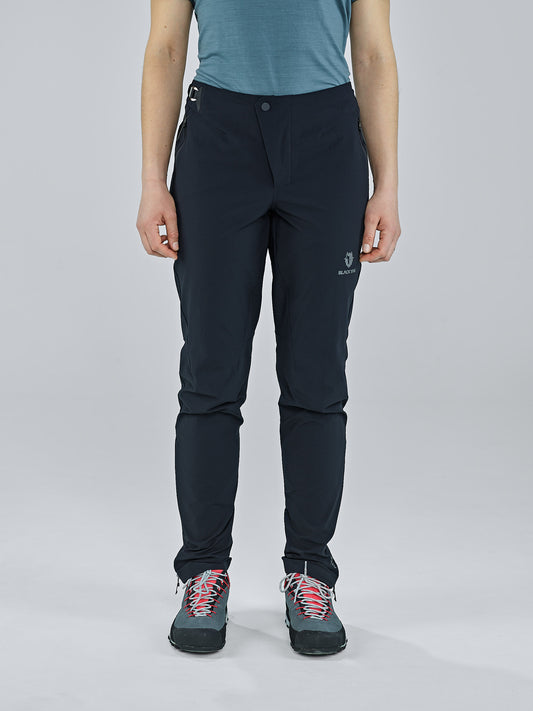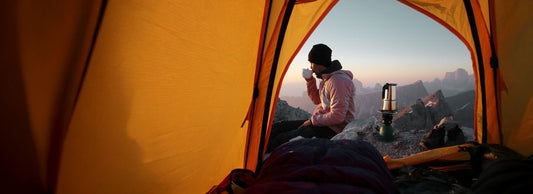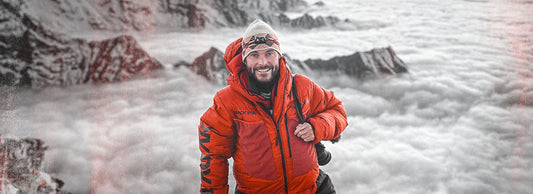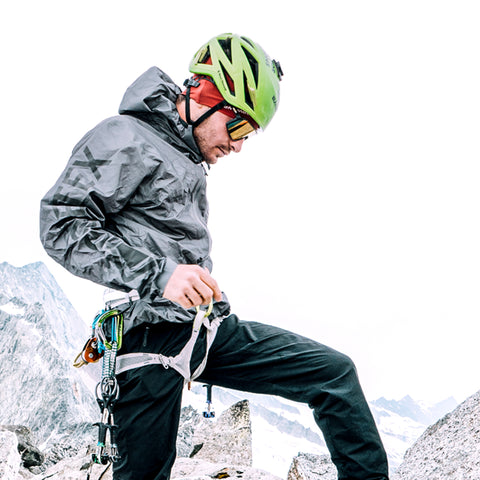Combining different mountain sports into a single tour opens up new perspectives and places high demands on planning, technique, and physical performance. Multisport tours are versatile and can be individually adapted to terrain, weather conditions, and personal preferences. The combination of mountaineering, climbing, ski touring, ice climbing, and paragliding opens new possibilities and requires a high level of experience and flexibility.
Piz Palü – Mixed Tour with Paragliding Descent
One of my favorite tours was the ascent of Piz Palü with my BLACKYAK colleague and best friend Michael Büchi. This tour held special meaning for me, as Piz Palü is a mountain with many personal memories. The route led through demanding mixed terrain and glacier sections to the summit—with the goal of flying down into the valley by paraglider from there.
Already during the planning phase, it was crucial to adhere to precise time windows, as we knew that clouds could move in during the day, making a paraglider launch impossible. An unexpected challenge arose on the way: there was much more snow than expected on the ridge, which slowed our progress and forced us to adapt our route flexibly.
Shortly before the summit, we had to decide on an alternative launch site to get airborne before the incoming clouds. We managed to take off just in time and flew safely into the valley. This tour was an impressive example of how important precise planning, quick decisions, and close teamwork are for multisport tours.

Planning and Logistical Challenges
Multisport tours require careful and precise preparation. Each integrated sport brings its own demands that must be considered.
Weather analysis: Each discipline has specific weather requirements. For paragliding, wind conditions and cloud cover are crucial; for climbing, rock conditions; for ice climbing, ice quality; and for ski touring, snow conditions and avalanche risk.
Equipment management: A balanced trade-off between necessary gear and weight reduction is essential. Those undertaking multisport tours must know their own abilities well to consciously decide which equipment can be left behind.
Time management: Clear time windows and fixed points are essential. If these are not adhered to, the goal of the tour may be jeopardized. In such cases, the plan must be adapted or even abandoned if necessary.

The Paraglider as an Efficient Descent Tool
The use of paragliders in high alpine terrain is increasingly being recognized by mountaineers as a valuable addition. The descent is often the most dangerous part of a tour—fatigue, slippery sections, and difficult terrain increase the risk of accidents. A paraglider descent can minimize this risk and offers several advantages:
- Safety: Many mountain accidents happen during the descent. A well-planned paraglider launch largely eliminates this risk.
- Speed: A flight can save hours of descending and allows large altitude differences to be covered with minimal physical exertion.
- Flexibility: Lightweight equipment like modern hike-and-fly paragliders can be integrated into an alpine tour without significantly restricting mobility.
Equipment Requirements for Multisport Tours
The right equipment is key to efficiently combining the different sports.
- Backpack: Lightweight and functional, with good attachment options for crampons, ice axe, and skis
- Clothing: Functional layering systems suitable for both the ascent and the flight. An absolute must-have for such tours is the JAVARI GORE-TEX® 3L.
- Paraglider: Models with compact packing size and an optimal weight-to-performance ratio.
- First aid kit: Minimalist but well thought-out—with bandages, painkillers, an emergency blanket, and an emergency communication device such as a Garmin inReach or a smartphone with satellite function.

Conclusion
Multisport adventures demand a high level of planning, technical skill, and physical capability. Combining different disciplines allows for a more efficient use of alpine terrain and opens up entirely new opportunities in modern mountain sports.
The paraglider in particular is increasingly being recognized as a valuable tool, as it makes descent safer and faster. Those who are willing to deeply engage with the requirements can unlock the full potential of this form of mountaineering—and discover entirely new horizons.
"I hope that, just like me, you’ll discover the fascination, challenge, and indescribable freedom that lies in the combination of different disciplines. There’s hardly a more intense feeling than gliding down into the valley with a paraglider after a demanding tour—a moment in which effort, planning, and adventure seamlessly merge together."
– Flavio Caduff
-
MEN´S JAVARI GORE-TEX 3L ACTIVE SHELL JACKET
Minimalism meets maximum functionality. Weighing just 171 grams, the GTX JAVA...Regular price 230,00 €Regular priceUnit price per -
WOMEN´S DANGI OUTDOOR PANTS
The DANGI PANT is a lightweight and comfortable all-round outdoor pant made o...Regular price 190,00 €Regular priceUnit price per













